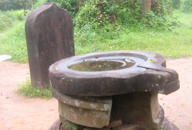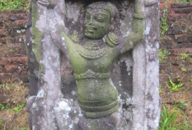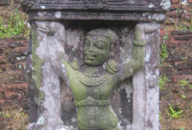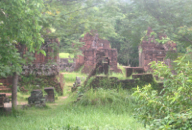my son ancient temples
hon quap mountain valley
My Son PROVINCE, centrAL VIETNAM
july 16, 2009


my son ancient temples
hon quap mountain valley
My Son PROVINCE, centrAL VIETNAM
july 16, 2009




The UNESCO World Heritage Site of My Son, at the foot of Hon Quap, or “Cat’s Tooth Mountain” is the site of ancient Hindu temples built by the early kingdom of Champa, which flourished between the 2nd and 15th centuries, 1000-1400 A.D. The temples, built in clustered groupings on this site, predate Angkor Wat by as many as 10 centuries, or one thousand years. Discovered by French archaeologists in the late 1890’s, the site has traces of 70 temples, with approximately 20 in good condition. Unfortunately, an entire group of temples was destroyed by American bombing during the Vietnamese War. Each of the towers which remains at My Son were built in three parts. The base represented earth, the center, the spiritual world, and the top, the realm which is between earth and heaven. Images carved in stone embellish these temples. In the gardens, phallic symbols, linga, are associated with the Hindu god, Shiva. Water would have been poured over this stone form, which was set inside a round hollow or yoni, representing the female principle. This act, with water flowing over the linga and from the spout of the yoni, symbolized creation. Most of the site is in ruined condition, except for one area, designated B, and its adjoining area, designated D. Two of the buildings in Group D, long halls that have been covered with modern roofs, house artifacts saved from the ruins of the bomb-damaged site. The artifacts both inside the museum and located around the areas, contain impressive carvings. Some of these decorate lintels. Others, carved of brick and sandstone, decorate the towers and sanctuaries, or kalan. Other carvings, including linga, figures, and a cow are simply scattered around the grounds of other sites. A one kilometer/0.6 mile road lead us into the site, while a narrow stone pathway served as an exit to the group of pavilions which served as a “Welcome” center. We covered the ground in an hour, having arrived early to avoid the crowds. The one hour drive from Hoi An, beginning at 6 AM, was filled with interesting activity and beautiful countryside, including quaint villages, markets, and farmers herding cattle or working in the rice paddies. Groups of high school students, boys and girls dressed in white shirts or blouses and black trousers, happily pedaled their bicycles to school, sometimes riding three abreast on a two-land highway, much to the consternation of our driver.
PHOTOS: Left Column: 1. The environment: a stone path leading through the tropical jungle from the sites to the Welcome center. 2. A stone carved yoni, upon which a linga would have stood. Water poured over the linga would have fallen from the spout of the yoni. 3. A carved figure, a Cham statue, now on view in the hall of Area D. 4. Exterior carving on a pillar dating from the 8th century. Center, Top: Kalan or temples in Area B: views look through one to another. Center, Bottom: Fragment, standing figure displayed indoors in Area D. I found it remarkable how “Egyptian” this stylized figure appeared to be. Right Column: 1. Temple ruins, all made of brick. 2. Stone carving of a bull. 3. An intricate stone carving depicting several dancing figures in landscape, and a cow. This is displayed in one of the halls in Area D. 4. Kalan carving detail depicting celestial figures and their Javanese influence.


Early Champa Kingdom







